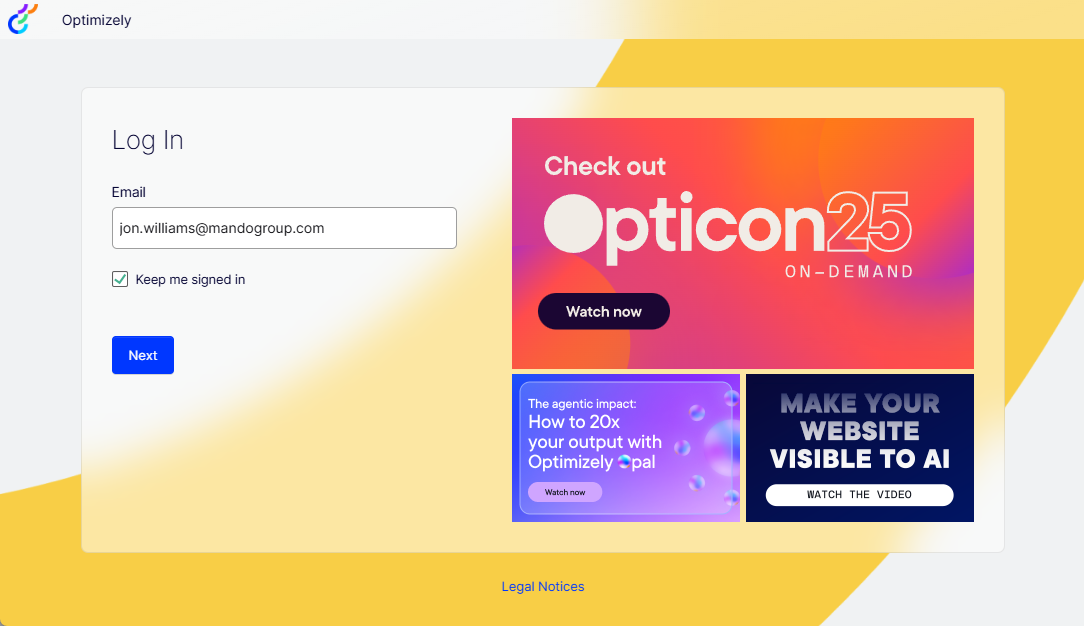Opti ID: What is it and why now is a good time to use it
If you’ve been hearing the term Opti ID floating around and wondering what the fuss is about, let’s break it down in plain English.
What is Opti ID at a high level?
Think of Opti ID as your one key to the Optimizely kingdom. Instead of juggling multiple logins for CMS, CMP, DXP, and other Optimizely tools, Opti ID gives you a single, secure identity across the board. It’s like having one passport for all the countries in the Optimizely world.
What advantages does it bring?
- One login, less hassle – No more remembering five different passwords.
- Better security – MFA support and modern protocols keep things locked down.
- Smooth onboarding – SCIM integration means user and group management is automated.
- Future-proof – Opti ID is becoming the standard for all Optimizely services.

What will happen if you don’t have Opti ID?
If you regularly work in the Optimizely ecosystem then you’ll start hitting roadblocks.
Some new services (like Optimizely's Opal AI functionality) will require Opti ID from the outset and other existing systems, such as the login to Optimizely World, are moving over to it. Without and Opti ID login, you’ll be stuck with fragmented access to Optimzely systems and manual user management. Basically, life gets harder.
What does this mean in the real world?
Picture this:
- You’re an editor working on CMS content, then need to jump into CMP for campaign planning or to upload a DAM asset. With Opti ID, you log in once and move seamlessly between these tools. Without it, you'll need to remember and input two separate passwords (and possibly usernames) for each of the systems - causing a break in your flow and frustration.
- Need to manage permissions for your team? Instead of fiddling with settings in multiple separate systems (CMS, CMP, ODP, etc.), you can do it centrally via Opti ID - being able to see exactly which systems a user has access to and which groups they are a member of in one place.
- Concerned about a bad guy guessing a password, logging into your CMS and inflicting significant reputational damage (and potentially locking everyone else out of the CMS)? You might want to implement multi-factor authentication (MFA) sooner rather than later. Luckily, that's baked into Opti ID too.

I'm interested. What do I need to consider?
There are a few things to consider before deciding whether to move over to using Opti ID. Some questions you will want to think about include:
- Do you need access to Optimizely systems such as Helpdesk support, Optimizely World, Optimizely Academy, etc? (Hint: If the answer to this is 'yes' then you will almost certainly need an Opti ID account.)
- Are you using more than one product from the Optimizely platform (e.g. CMS, CMP, ODP, etc.)?
- Are you using only Optimizely SaaS products (e.g. ODP, Web Experimentation, etc.) or do we need some small additional configuration and code changes to make this work (e.g. on PaaS CMS)?
- Do you need the additional security of multi-factor authentication (MFA) on our site or is a simple username and password still sufficient?
- Are you happy having a separate username and password (and optionally MFA) for Opti ID or do we want to tie this into our existing authentication system (e.g. Microsoft Entra ID, Okta, etc.)?
- Do you want to automatically sync users and groups from our existing authentication system into Opti ID or are we happy to manually create/duplicate these?
- How will you we manage the roll out and communication around this change?
- How will you test this to ensure that all login flows work (for all user types on all systems) before turning off the old authentication mechanisms?
I already log in to my laptop. Why can’t It just use that authentication?
Good question! It actually can. If your organisation uses Entra ID (formerly Azure AD) or another OIDC-compliant provider such as Okta or PingOne, you can configure Opti ID to trust that identity (rather than having a separate Opti ID username and password). So yes, your laptop login can carry over – you just need to set up the connection within the Optimizely Admin Centre.
Side note: Opti ID also supports SAML based authorisation to allow connectivity to legacy identity providers or those with OIDC restrictions.
How do I manage groups and permissions?
Users and groups can be easily created and centrally managed within the Optimizely Admin Centre. However, many organisations don't want to duplicate these (in Opti ID) and instead just want control them within their existing identity provider (e.g. Entra ID or Okta). To facilitate this, Opti ID supports SCIM provisioning, which means you can sync users and groups from your existing identity provider into the Opti ID platform. No need to duplicate this group membership configuration in two places or to manually add (potentially) hundreds of users within the Opti ID system!

I’ve not had to use this before. Why should I set up Opti ID now?
As mentioned above, new services like Opal already require it and many others, such as access to Optimizely World, Optimizely Academy and Support, are following suit. Setting it up now saves headaches later and gives you a single user account to access to the necessary systems.
Final thoughts
Opti ID isn’t just another login system – it’s the backbone of how Optimizely is moving forward. Get ahead of the curve, make life easier for your team, and lock down security while you’re at it.
If you need help understanding Opti ID, its benefits or technicalities further then please get in touch.
Related Links
- https://support.optimizely.com/hc/en-us/articles/32694161850381-Overview-of-Opti-ID
- https://world.optimizely.com/blogs/satata-satez/dates/2025/9/world-login-is-moving-to-optiid/
- https://support.optimizely.com/hc/en-us/articles/25450783599117-Overview-of-the-Opti-ID-Admin-Center
- https://support.optimizely.com/hc/en-us/articles/22954897492109-2025-Opti-ID-release-notes
- https://support.optimizely.com/hc/en-us/articles/32769522265485-Overview-of-SCIM-provisioning-for-Opti-ID

Comments